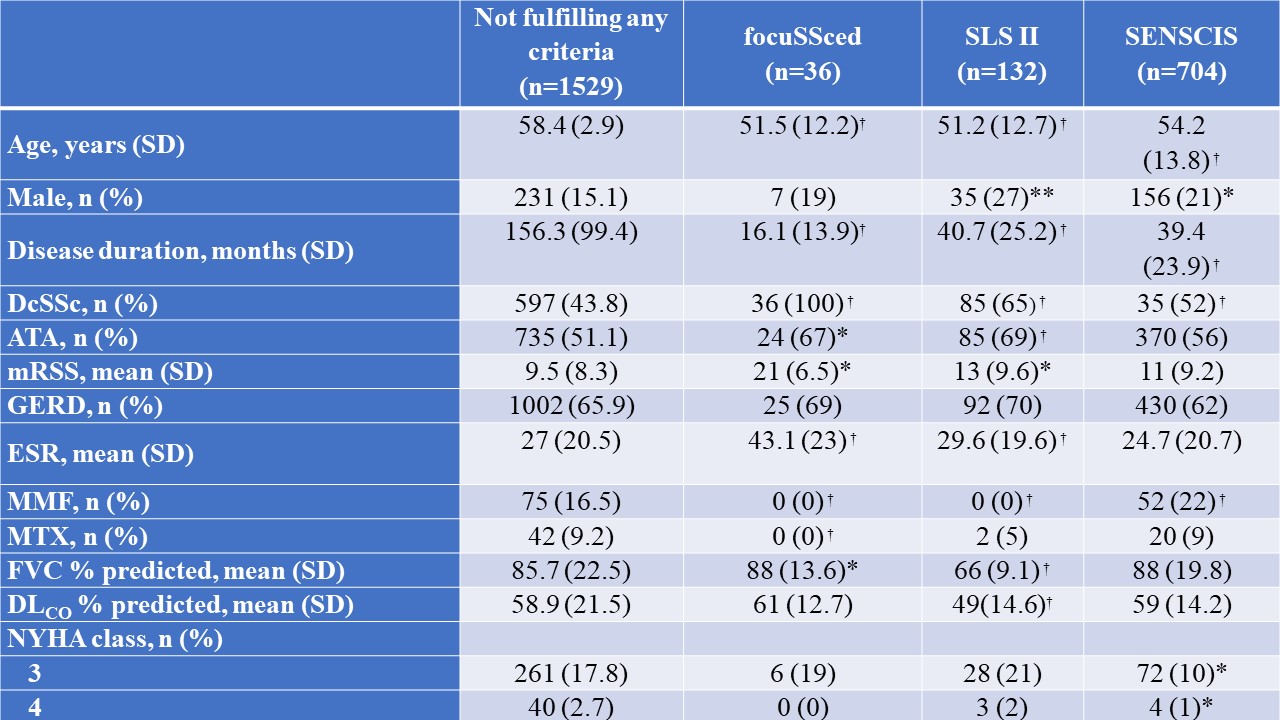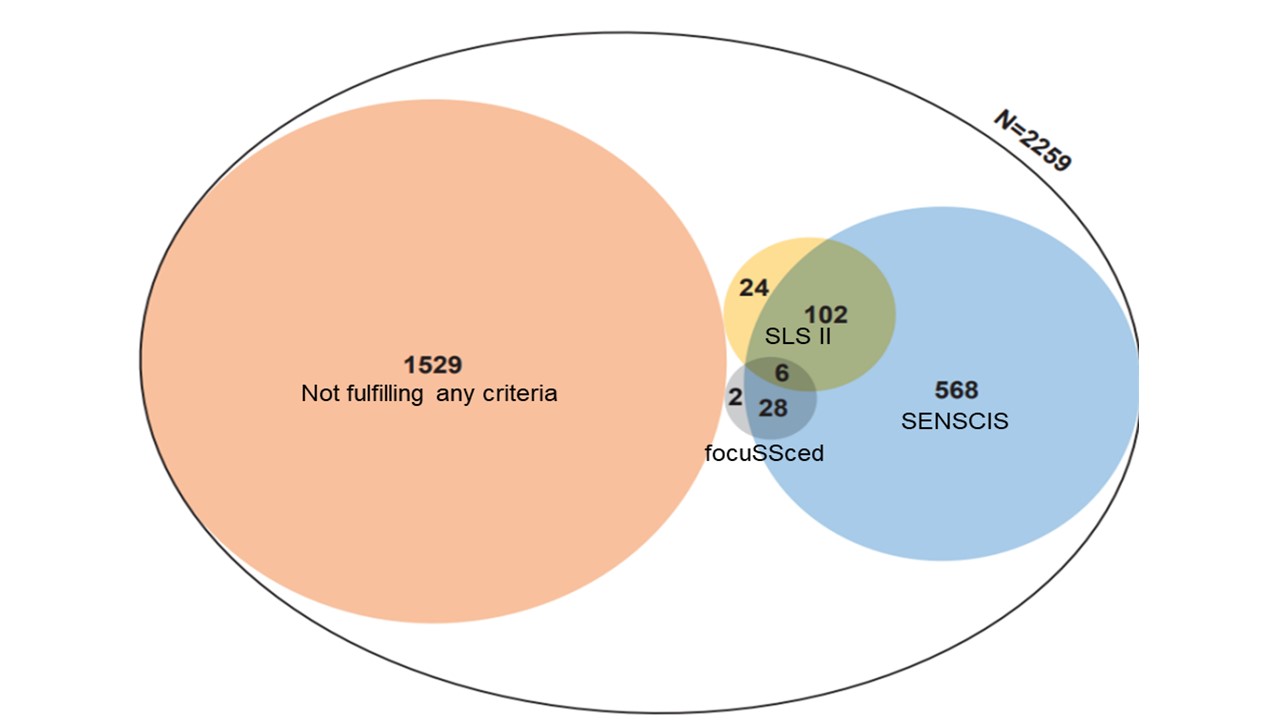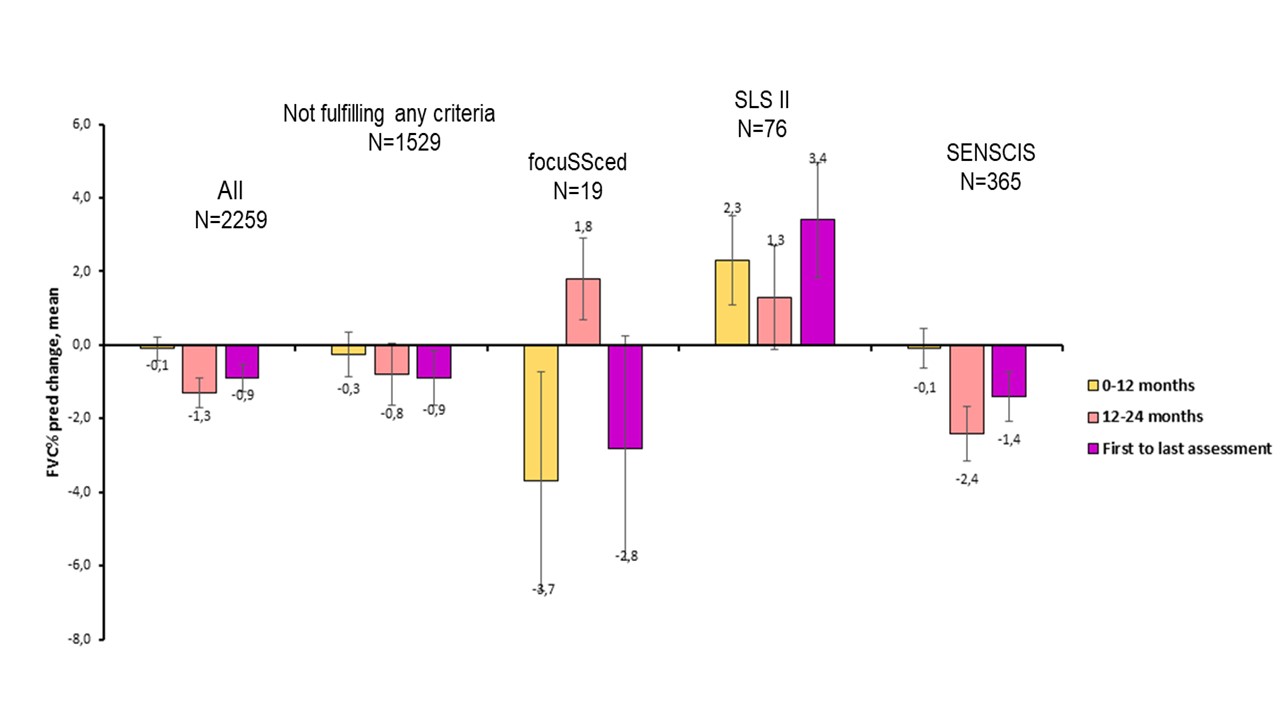Back
Abstract Session
Fibrosing rheumatic diseases (scleroderma, MCTD, IgG4-related disease, scleroderma mimics)
Session: Abstracts: Systemic Sclerosis and Related Disorders – Clinical I: Trials and Therapeutics (0518–0523)
0522: Cohort Enrichment Strategies for Progressive Interstitial Lung Disease in Systemic Sclerosis from EUSTAR
Saturday, November 12, 2022
4:00 PM – 4:10 PM Eastern Time
Location: Room 121
- AH
Anna-Maria Hoffmann-Vold, MD, PhD
Oslo University Hospital
Oslo, Norway
Presenting Author(s)
Anna-Maria Hoffmann-Vold1, Cathrine Brunborg1, Paolo Airò2, Lidia P. Ananyeva3, László Czirják4, Serena Guiducci5, Eric Hachulla6, MENGTAO LI7, Carina Mihai8, Gabriela Riemekasten9, Petros P. Sfikakis10, Gabriele Valentini11, Otylia Kowal-Bielecka12, Yannick Allanore13 and Oliver Distler8, 1Oslo University Hospital, Oslo, Norway, 2Rheumatology and Clinical Immunology Unit, ASST Spedali Civili, Brescia, Italy, 3V.A. Nasonova Research Institute of Rheumatology, Moscow, Russia, 4Medical school of Pécs, Pecs, Hungary, 5University of Firenze, Firenze, Italy, 6University of Lille, Lille, France, 7Department of Rheumatology and Clinical Immunology, Peking Union Medical College Hospital, Peking Union Medical College & Chinese Academy of Medical Sciences, National Clinical Research Center for Dermatologic and Immunologic Diseases, Ministry of Science & Technology, Key Laboratory of Rheumatology and Clinical Immunology, Ministry of Education, State Key Laboratory of Complex Severe and Rare Diseases, Ministry of Science & Technology, Beijing, China, 8Department of Rheumatology, University Hospital Zurich, University of Zurich, Zürich, Switzerland, 9University Clinic Schleswit-Holstein (UKSH), Luebeck, Germany, 10Joint Academic Rheumatology Program, National and Kapodistrian University of Athens, School of Medicine, Athens, Greece, 11Università della Campania “Luigi Vanvitelli”, Napoli, Italy, 12Medical University of Bialystok, Bialystok, Poland, 13Department of Rheumatology A, Descartes University, APHP, Cochin Hospital, Paris, France, Paris, France
Background/Purpose: Enrichment strategies from clinical trials for progressive systemic sclerosis-associated interstitial lung disease (SSc-ILD) have been partly successful but have not been tested in a real life cohort. The objective of this study was to analyse the feasibility, representativeness and efficacy of enrichment strategies in SSc-ILD patients from the EUSTAR cohort.
Methods: We applied the (partly modified) inclusion criteria of major recent SSc-ILD trials (focuSSced, SLS II and SENSCIS) in SSc-ILD patients and assessed progressive ILD, defined as absolute change in forced vital capacity (FVC) and as significant progression (FVC decline >10%) over time. Data were compared to patients not fulfilling any inclusion criteria.
Results: In total, 2258 SSc-ILD patients were included, with 31.2% meeting SENSCIS, 5.8% SLS II, 1.6% focuSSced criteria and 1529 (67.7%) not meeting any criteria, highlighting reduced feasibility of recruitment of SSc-ILD patients into clinical trials (Figure 1). We also showed a selection of patient populations with changed representativeness (Table). In the first 12+/-3 months, a slow FVC% decline of –0.1% was seen in the total, unselected cohort and in patients fulfilling SENSCIS criteria. Patients fulfilling criteria from focuSSced showed a strong FVC decline of –3.7%. Notably, patients enriched for SLS II criteria showed FVC improvement of +2.3% (Figure 2). Similarly, compared to the total unselected cohort, the number of significant progressive events was numerically higher in patients fulfilling focuSSced criteria, the same for SENSCIS criteria and even slightly lower for patients fulfilling the SLS2 criteria
In the second 12 months period, SENSCIS enriched patients had a further absolute FVC% decline as described for the total cohort. In contrast, patients fulfilling the focuSSced and SLS II inclusion criteria showed numerical improvement of lung function in the second period (Figure 2). There were no significant associations of enrichment criteria and ILD progression in the second period.
Over the mean observation period of 2.3 years, patients not fulfilling any inclusion criteria showed the same FVC decline of –0.9 (12.1) as observed for the total cohort (–0.9% (12.6)). There were numerical differences in FVC changes in the enriched patient cohorts, varying from –2.8% FVC decline in patients fulfilling the focuSSced criteria to +3.4% FVC improvement with SLS II criteria.
Conclusion: Application of enrichment criteria from previous clinical trials showed enrichment for progression with variable success but led to selected patient populations reducing feasibility of recruitment and representativeness of the SSc-ILD patients. These findings are important for future clinical trial design and interpretation of the results of published trials.
 Table. Demographics and baseline clinical characteristics of EUSTAR patients
Table. Demographics and baseline clinical characteristics of EUSTAR patients
 Figure 1: Number of SSc-ILD patients fulfilling none or any inclusion criteria
Figure 1: Number of SSc-ILD patients fulfilling none or any inclusion criteria
 Figure 2: FVC% pred decline in all, patients not fulfilling any criteria, the focuSSced, SLS II or Senscis criteria
Figure 2: FVC% pred decline in all, patients not fulfilling any criteria, the focuSSced, SLS II or Senscis criteria
Disclosures: A. Hoffmann-Vold, Boehringer-Ingelheim, Janssen, Eli Lilly, Merck/MSD, Roche; C. Brunborg, None; P. Airò, Bristol-Myers-Squibb, Boehringer Ingelheim, Roche, Jannsen, CSL Behring; L. Ananyeva, Boehringer-Ingelheim; L. Czirják, Boehringer Ingelheim, Actelion, MSD, Novartis, Pfizer; S. Guiducci, None; E. Hachulla, GSK, Roche-Chugai, Johnson & Johnson, Boehringer Ingelheim, CSL Behring, Sanofi Genzyme; M. LI, None; C. Mihai, Boehringer-Ingelheim, Mepha, MEDTalks, Roche, Janssen; G. Riemekasten, Boehringer Ingelheim; P. Sfikakis, Pfizer, AbbVie/Abbott, Novartis, Amgen, Janssen, Boehringer-Ingelheim, Celgene, Eli Lilly; G. Valentini, Boehringer Ingelheim, Sanofi/BMS; O. Kowal-Bielecka, CSL Behring, Boehringer Ingelheim, Gilead, Novartis, Abbvie, Janssen-Cilag, Medac, MSD, Roche; Y. Allanore, Boehringer Ingelheim, Sanofi, Janssen, AbbVie, Menarini, Curzion, Medsenic, Prometheus, AstraZeneca; O. Distler, AbbVie/Abbott, Amgen, GlaxoSmithKlein(GSK), Novartis, Roche, UCB, Kymera, Mitsubishi Tanabe, Boehringer Ingelheim, 4P-Pharma, Acceleron, Alcimed, Altavant Sciences, AnaMar, Arxx, AstraZeneca, Blade Therapeutics, Bayer, Corbus Pharmaceuticals, CSL Behring, Galapagos, Glenmark, Horizon, Inventiva, Lupin, Miltenyi Biotec, Merck/MSD, Prometheus Biosciences, Redx Pharma, Roivant, Sanofi, Topadur, Pfizer, Janssen, Medscape, Patent issued “mir-29 for the treatment of systemic sclerosis” (US8247389, EP2331143), FOREUM Foundation, ERS/EULAR Guidelines, EUSTAR, SCQM (Swiss Clinical Quality Management in Rheumatic Diseases), Swiss Academy of Medical Sciences (SAMW), Hartmann Müller Foundation.
Background/Purpose: Enrichment strategies from clinical trials for progressive systemic sclerosis-associated interstitial lung disease (SSc-ILD) have been partly successful but have not been tested in a real life cohort. The objective of this study was to analyse the feasibility, representativeness and efficacy of enrichment strategies in SSc-ILD patients from the EUSTAR cohort.
Methods: We applied the (partly modified) inclusion criteria of major recent SSc-ILD trials (focuSSced, SLS II and SENSCIS) in SSc-ILD patients and assessed progressive ILD, defined as absolute change in forced vital capacity (FVC) and as significant progression (FVC decline >10%) over time. Data were compared to patients not fulfilling any inclusion criteria.
Results: In total, 2258 SSc-ILD patients were included, with 31.2% meeting SENSCIS, 5.8% SLS II, 1.6% focuSSced criteria and 1529 (67.7%) not meeting any criteria, highlighting reduced feasibility of recruitment of SSc-ILD patients into clinical trials (Figure 1). We also showed a selection of patient populations with changed representativeness (Table). In the first 12+/-3 months, a slow FVC% decline of –0.1% was seen in the total, unselected cohort and in patients fulfilling SENSCIS criteria. Patients fulfilling criteria from focuSSced showed a strong FVC decline of –3.7%. Notably, patients enriched for SLS II criteria showed FVC improvement of +2.3% (Figure 2). Similarly, compared to the total unselected cohort, the number of significant progressive events was numerically higher in patients fulfilling focuSSced criteria, the same for SENSCIS criteria and even slightly lower for patients fulfilling the SLS2 criteria
In the second 12 months period, SENSCIS enriched patients had a further absolute FVC% decline as described for the total cohort. In contrast, patients fulfilling the focuSSced and SLS II inclusion criteria showed numerical improvement of lung function in the second period (Figure 2). There were no significant associations of enrichment criteria and ILD progression in the second period.
Over the mean observation period of 2.3 years, patients not fulfilling any inclusion criteria showed the same FVC decline of –0.9 (12.1) as observed for the total cohort (–0.9% (12.6)). There were numerical differences in FVC changes in the enriched patient cohorts, varying from –2.8% FVC decline in patients fulfilling the focuSSced criteria to +3.4% FVC improvement with SLS II criteria.
Conclusion: Application of enrichment criteria from previous clinical trials showed enrichment for progression with variable success but led to selected patient populations reducing feasibility of recruitment and representativeness of the SSc-ILD patients. These findings are important for future clinical trial design and interpretation of the results of published trials.
 Table. Demographics and baseline clinical characteristics of EUSTAR patients
Table. Demographics and baseline clinical characteristics of EUSTAR patients Figure 1: Number of SSc-ILD patients fulfilling none or any inclusion criteria
Figure 1: Number of SSc-ILD patients fulfilling none or any inclusion criteria  Figure 2: FVC% pred decline in all, patients not fulfilling any criteria, the focuSSced, SLS II or Senscis criteria
Figure 2: FVC% pred decline in all, patients not fulfilling any criteria, the focuSSced, SLS II or Senscis criteriaDisclosures: A. Hoffmann-Vold, Boehringer-Ingelheim, Janssen, Eli Lilly, Merck/MSD, Roche; C. Brunborg, None; P. Airò, Bristol-Myers-Squibb, Boehringer Ingelheim, Roche, Jannsen, CSL Behring; L. Ananyeva, Boehringer-Ingelheim; L. Czirják, Boehringer Ingelheim, Actelion, MSD, Novartis, Pfizer; S. Guiducci, None; E. Hachulla, GSK, Roche-Chugai, Johnson & Johnson, Boehringer Ingelheim, CSL Behring, Sanofi Genzyme; M. LI, None; C. Mihai, Boehringer-Ingelheim, Mepha, MEDTalks, Roche, Janssen; G. Riemekasten, Boehringer Ingelheim; P. Sfikakis, Pfizer, AbbVie/Abbott, Novartis, Amgen, Janssen, Boehringer-Ingelheim, Celgene, Eli Lilly; G. Valentini, Boehringer Ingelheim, Sanofi/BMS; O. Kowal-Bielecka, CSL Behring, Boehringer Ingelheim, Gilead, Novartis, Abbvie, Janssen-Cilag, Medac, MSD, Roche; Y. Allanore, Boehringer Ingelheim, Sanofi, Janssen, AbbVie, Menarini, Curzion, Medsenic, Prometheus, AstraZeneca; O. Distler, AbbVie/Abbott, Amgen, GlaxoSmithKlein(GSK), Novartis, Roche, UCB, Kymera, Mitsubishi Tanabe, Boehringer Ingelheim, 4P-Pharma, Acceleron, Alcimed, Altavant Sciences, AnaMar, Arxx, AstraZeneca, Blade Therapeutics, Bayer, Corbus Pharmaceuticals, CSL Behring, Galapagos, Glenmark, Horizon, Inventiva, Lupin, Miltenyi Biotec, Merck/MSD, Prometheus Biosciences, Redx Pharma, Roivant, Sanofi, Topadur, Pfizer, Janssen, Medscape, Patent issued “mir-29 for the treatment of systemic sclerosis” (US8247389, EP2331143), FOREUM Foundation, ERS/EULAR Guidelines, EUSTAR, SCQM (Swiss Clinical Quality Management in Rheumatic Diseases), Swiss Academy of Medical Sciences (SAMW), Hartmann Müller Foundation.

